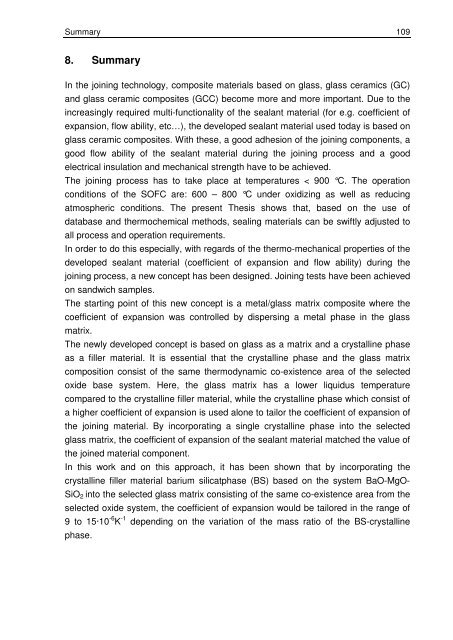T °C - JuSER - Forschungszentrum Jülich
T °C - JuSER - Forschungszentrum Jülich
T °C - JuSER - Forschungszentrum Jülich
Sie wollen auch ein ePaper? Erhöhen Sie die Reichweite Ihrer Titel.
YUMPU macht aus Druck-PDFs automatisch weboptimierte ePaper, die Google liebt.
Summary 109<br />
8. Summary<br />
In the joining technology, composite materials based on glass, glass ceramics (GC)<br />
and glass ceramic composites (GCC) become more and more important. Due to the<br />
increasingly required multi-functionality of the sealant material (for e.g. coefficient of<br />
expansion, flow ability, etc…), the developed sealant material used today is based on<br />
glass ceramic composites. With these, a good adhesion of the joining components, a<br />
good flow ability of the sealant material during the joining process and a good<br />
electrical insulation and mechanical strength have to be achieved.<br />
The joining process has to take place at temperatures < 900 <strong>°C</strong>. The operation<br />
conditions of the SOFC are: 600 – 800 <strong>°C</strong> under oxidizing as well as reducing<br />
atmospheric conditions. The present Thesis shows that, based on the use of<br />
database and thermochemical methods, sealing materials can be swiftly adjusted to<br />
all process and operation requirements.<br />
In order to do this especially, with regards of the thermo-mechanical properties of the<br />
developed sealant material (coefficient of expansion and flow ability) during the<br />
joining process, a new concept has been designed. Joining tests have been achieved<br />
on sandwich samples.<br />
The starting point of this new concept is a metal/glass matrix composite where the<br />
coefficient of expansion was controlled by dispersing a metal phase in the glass<br />
matrix.<br />
The newly developed concept is based on glass as a matrix and a crystalline phase<br />
as a filler material. It is essential that the crystalline phase and the glass matrix<br />
composition consist of the same thermodynamic co-existence area of the selected<br />
oxide base system. Here, the glass matrix has a lower liquidus temperature<br />
compared to the crystalline filler material, while the crystalline phase which consist of<br />
a higher coefficient of expansion is used alone to tailor the coefficient of expansion of<br />
the joining material. By incorporating a single crystalline phase into the selected<br />
glass matrix, the coefficient of expansion of the sealant material matched the value of<br />
the joined material component.<br />
In this work and on this approach, it has been shown that by incorporating the<br />
crystalline filler material barium silicatphase (BS) based on the system BaO-MgO-<br />
SiO2 into the selected glass matrix consisting of the same co-existence area from the<br />
selected oxide system, the coefficient of expansion would be tailored in the range of<br />
9 to 15·10 -6 K -1 depending on the variation of the mass ratio of the BS-crystalline<br />
phase.
















